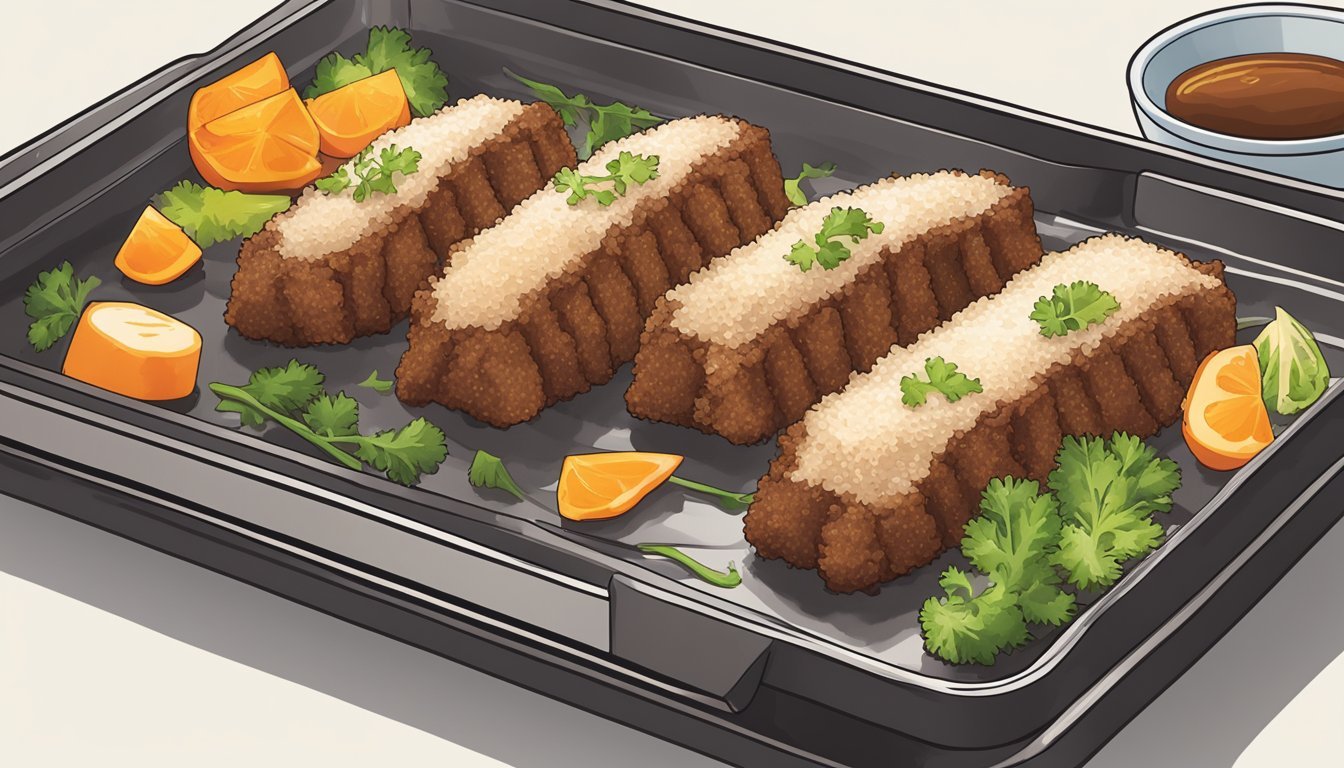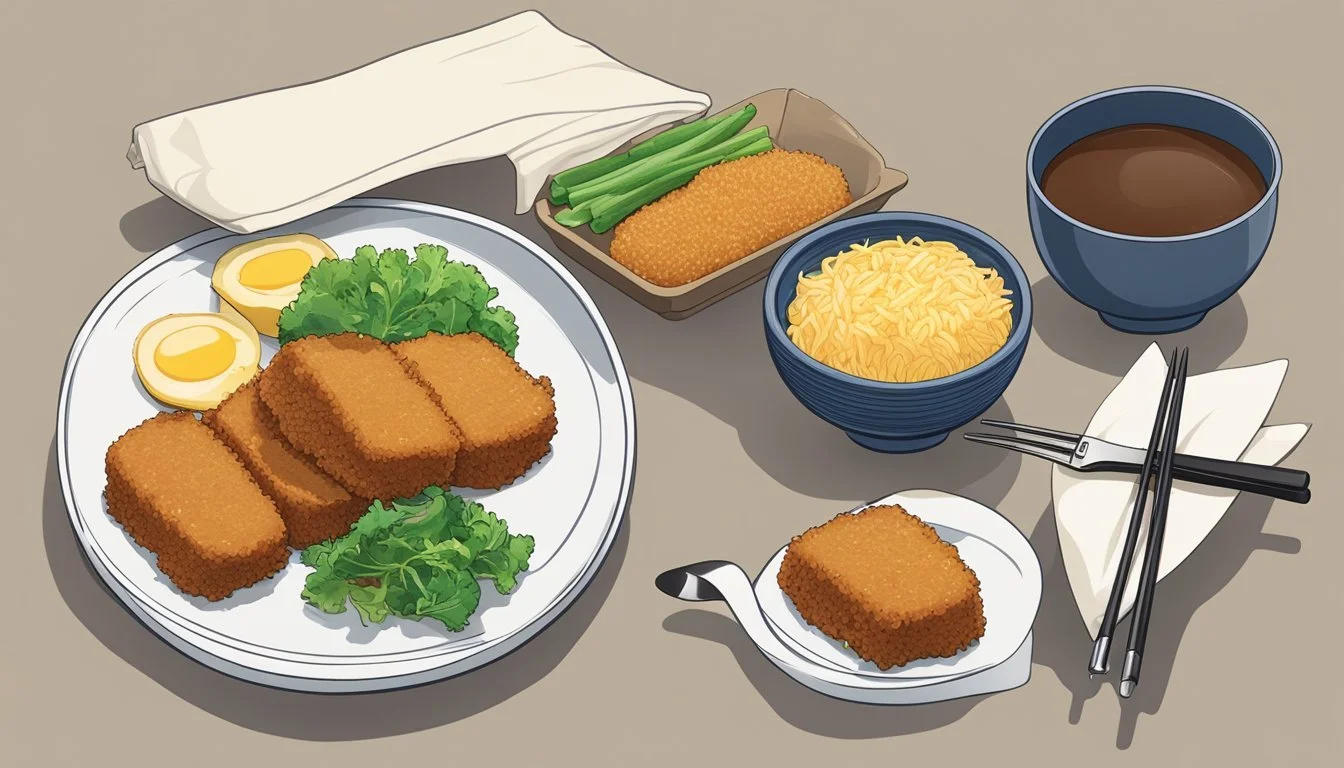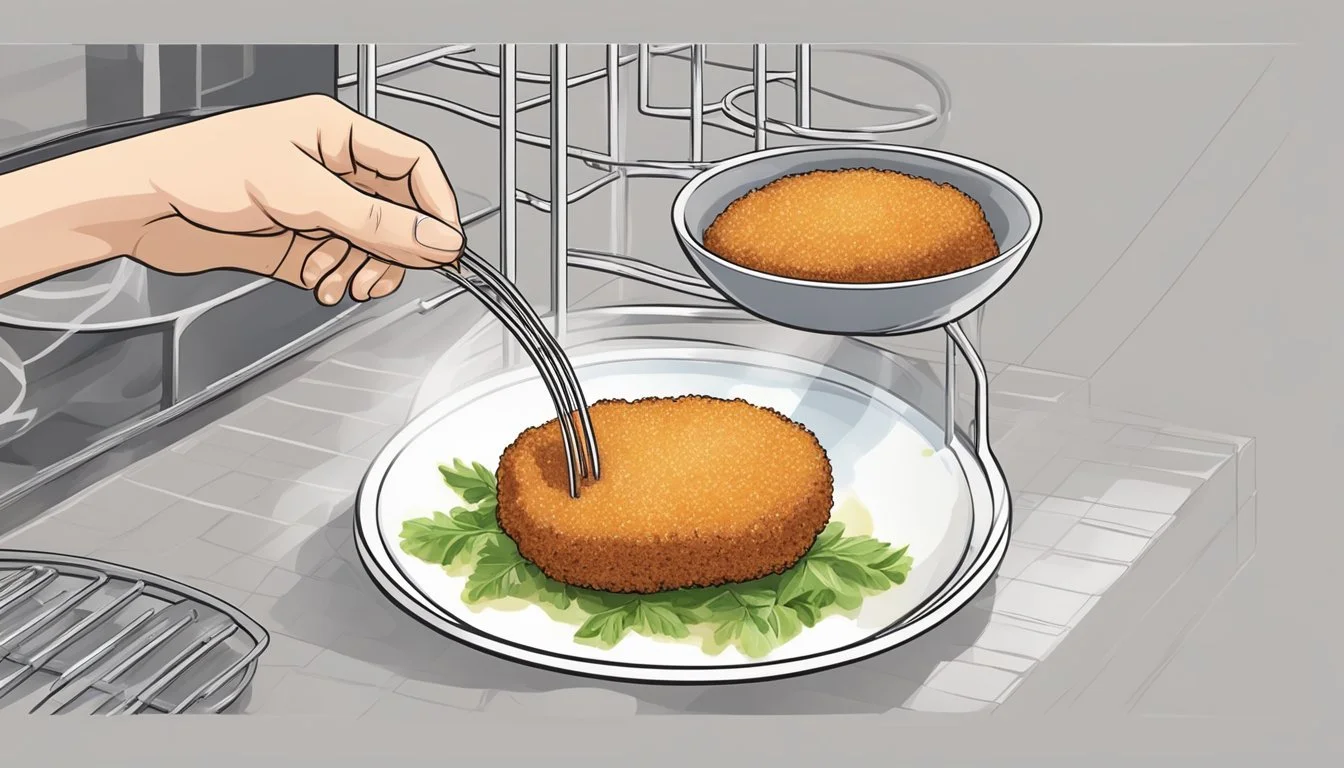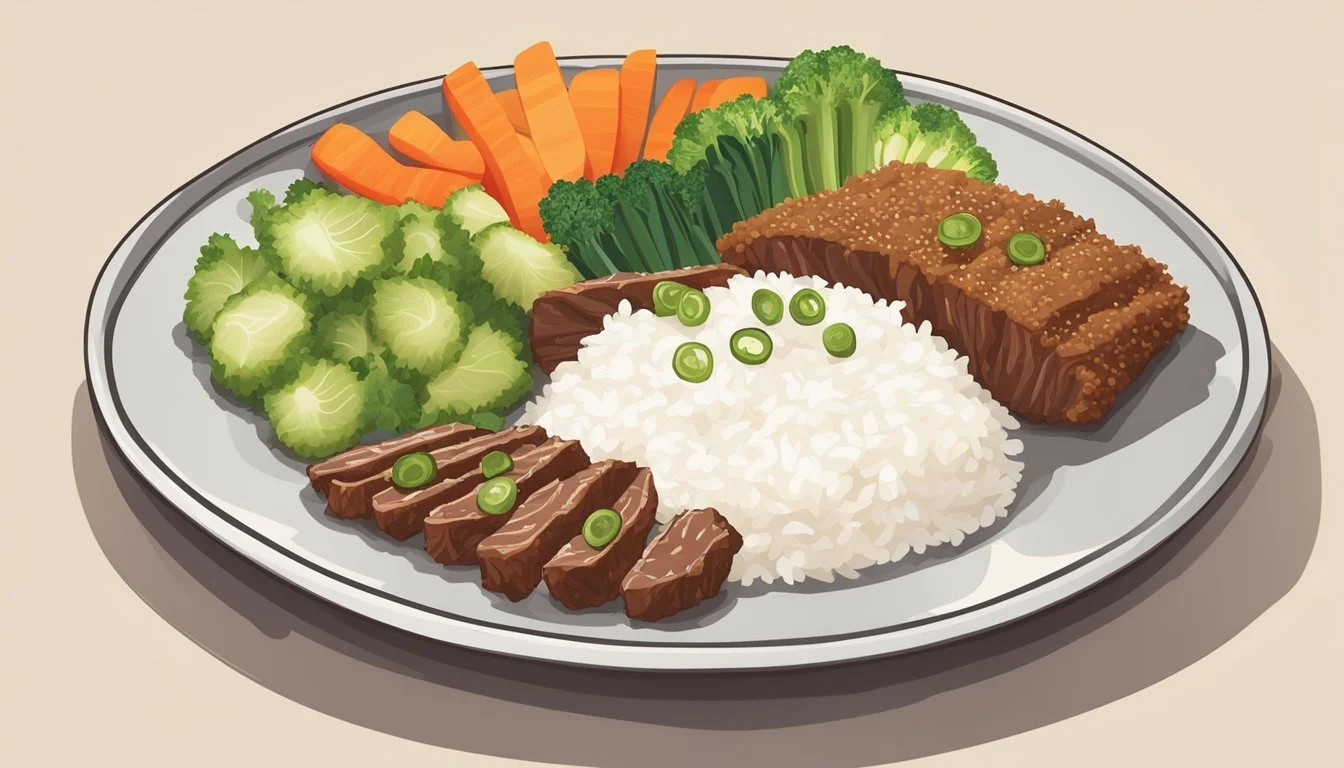How to Reheat Beef Katsu for Maximum Flavor and Crispiness
Reheating beef katsu to its original crispy and tender perfection is a straightforward process that any home cook can master. This beloved Japanese dish, known as gyukatsu when made with beef, features a crunchy exterior and juicy interior that can easily be lost if not reheated properly. The best way to reheat beef katsu is by using an oven preheated to 375°F (190°C), which ensures that the katsu is warmed thoroughly without sacrificing its crispiness.
To begin, place the cold beef katsu on a baking sheet lined with parchment paper. Cover it loosely with aluminum foil to retain moisture and prevent excessive browning. Heat the katsu in the oven for 10-15 minutes, checking to ensure it is hot all the way through. For additional crispiness, remove the foil for the last few minutes of heating.
Another effective method involves using a frying pan to quickly bring back the katsu’s crunch. Heat a small amount of oil in a pan, and once hot, add the beef katsu. Fry for a couple of minutes on each side until it is reheated and crispy. Both of these methods will help you enjoy your beef katsu as if it were freshly made, capturing the essence of this delicious Japanese delicacy.
Understanding Beef Katsu
Beef Katsu is a Japanese dish where beef fillets are coated in panko bread crumbs and deep-fried until crispy. This section will explore the distinct characteristics of Beef Katsu and how it compares to other katsu varieties such as Tonkatsu and Chicken Katsu.
Distinct Features of Beef Katsu
Beef Katsu is typically made using high-quality beef cuts such as filet mignon or sirloin. The use of Wagyu beef can further enhance the dish’s flavor and tenderness, providing a rich and buttery taste. The beef is seasoned with salt and pepper, then coated in flour, beaten eggs, and panko bread crumbs.
Panko bread crumbs are crucial as they create a light and crispy texture when deep-fried. Unlike traditional breadcrumbs, panko is larger and flakier, which helps in achieving a perfect crunch. The deep-frying process must be carefully managed to ensure the beef remains juicy inside while the exterior stays golden brown and crispy.
Comparing Beef Katsu to Other Katsu Varieties
Tonkatsu is made with pork cutlets, most commonly pork loin or tenderloin, and is also deep-fried with a panko coating. While the preparation method is similar to Beef Katsu, Tonkatsu has a slightly different flavor profile due to the distinct taste of pork.
Chicken Katsu involves using chicken breasts, which are often pounded to an even thickness before coating and frying. Chicken Katsu offers a lighter meat option with a less robust flavor compared to beef or pork.
Beef Katsu stands out due to the rich, hearty flavor of beef. The choice of beef cut, such as Wagyu, can significantly elevate the dish’s overall quality, making it a more luxurious option in the katsu family. While each katsu variety has its unique appeal, Beef Katsu offers a distinctive taste experience that sets it apart.
Preparation Before Reheating
Proper preparation is crucial to ensuring that reheated beef katsu retains its flavor and texture. Key factors include how the katsu is stored and how it is thawed if it has been frozen.
Storage Tips for Beef Katsu
To maintain the quality of beef katsu, refrigerate leftovers as soon as possible. Place the katsu on a plate lined with a paper towel to absorb excess oil. Cover the plate loosely with aluminum foil to preserve moisture and prevent odors from the refrigerator from affecting the katsu.
For longer storage, freezing is a viable option. Wrap individual portions tightly in plastic wrap, then place them in a freezer bag. Label the bag with the date to track storage time. Beef katsu can be frozen for up to one month without significantly losing quality.
Thawing Frozen Beef Katsu
Thaw frozen beef katsu in the refrigerator to ensure even thawing. This method prevents bacteria growth that can occur at room temperature. Place the wrapped katsu on a plate to catch any potential drips.
In case you need to thaw it quickly, you can use the microwave. Use the defrost setting or set it to a low power level. Check every 30 seconds to prevent partial cooking. Once thawed, it is ready for reheating using your preferred method.
Reheating Beef Katsu
Reheating beef katsu properly is essential to maintain its crispy exterior and tender inside. The following methods ensure the best texture and flavor, depending on the equipment available.
Oven Method
Preheat the oven to 350°F (175°C). Place the beef katsu on a baking sheet lined with parchment paper or aluminum foil. To avoid the katsu sitting in oil and becoming soggy, use a wire rack.
Lightly spray the katsu with cooking spray to enhance crispiness. Heat for around 10-15 minutes, flipping halfway through to ensure even reheating. The internal temperature should reach at least 165°F (74°C). Allow it to rest for a few minutes before serving to let the juices redistribute.
Stovetop Method
Use a non-stick pan for this method. Preheat the pan over medium heat and add a small amount of oil. Place the beef katsu in the pan, being careful not to overcrowd it.
Cook for 3-4 minutes on each side or until the exterior is crispy and the meat is warmed through. To achieve the best result, control the oil temperature and avoid scorching. This method keeps the exterior crunchy while ensuring the meat remains juicy.
Microwave Method
Although fast, this method may not keep the katsu as crispy. Place the beef katsu on a microwave-safe plate and cover it with a damp paper towel. This prevents the meat from drying out.
Microwave on medium power in 30-second intervals, checking and flipping it each time. Typically, it will take about 1-2 minutes. To crisp up the exterior, consider using the microwave only for preheating purposes and finish reheating in a non-stick pan.
Air Fryer Method
Preheat the air fryer to 375°F (190°C). Lightly spray the basket with cooking spray to prevent sticking. Arrange the beef katsu pieces in a single layer, without overlapping.
Reheat for about 5-7 minutes, shaking the basket halfway through to ensure even crisping. The air fryer method is excellent for maintaining a crispy outside while making sure the meat stays tender inside.
Making Beef Katsu from Scratch
Creating beef katsu from scratch involves selecting your ingredients carefully and following a series of steps to ensure a crispy, tender result.
Required Ingredients
For preparing beef katsu, these ingredients are essential:
Beef: Choose a tender cut like sirloin or tenderloin, cut to your desired thickness.
Salt and Pepper: For seasoning the beef.
All-Purpose Flour: Used as the first coating layer.
Eggs: Beaten in a bowl to create the second coating layer.
Milk: Adds a touch of creaminess to the egg mixture.
Panko Breadcrumbs: Japanese breadcrumbs that provide the katsu's signature crunch.
Oil: For frying the katsu to a golden brown finish. Preferred oils include vegetable or canola oil due to their high smoke points.
Step-by-Step Cooking Instructions
Prepare the Beef: Cut the beef to your desired thickness. Season both sides with salt and pepper.
Coat the Beef: Set up three bowls: one with all-purpose flour, one with beaten eggs mixed with a tablespoon of milk, and one with panko breadcrumbs. Dredge the beef first in flour, then dip it into the egg mixture, and finally coat it thoroughly with panko breadcrumbs.
Fry the Beef: Heat oil in a deep frying pan to 350°F (175°C). Carefully add the coated beef to the hot oil. Fry until the exterior is golden brown and crispy, usually about 2-3 minutes per side. Ensure not to overcrowd the pan to maintain the oil temperature.
Drain and Serve: Place the fried katsu on a paper towel-lined plate to drain any excess oil. Serve hot with a side of tonkatsu sauce or your preferred dipping sauce.
Accompaniments and Side Dishes
Beef katsu pairs excellently with a variety of traditional side dishes and flavorful sauces that enhance its taste and texture. Here are the key sides and condiments that accompany this crispy delight.
Traditional Side Dishes
Steamed Rice serves as a classic pairing for beef katsu, offering a neutral base that complements the dish's rich, crispy coating.
Miso Soup is another staple side, providing a warm and savory contrast to the crispy beef. It also adds a depth of umami flavor with its fermented soybean paste.
A Green Salad, often made with lettuce, tomatoes, and cucumbers, adds freshness to the meal and balances the heavier fried elements.
Shredded Cabbage is frequently served alongside beef katsu. Lightly dressed with a tangy vinaigrette, it offers a crunchy counterpoint and helps cut through the richness of the katsu.
Mashed Potatoes are less traditional but still popular, providing a creamy and comforting side that pairs well with the crispy beef.
Sauces and Condiments
Katsu Sauce is a must for beef katsu. This thick, fruity sauce is similar to Worcestershire but sweeter, making it perfect for dipping.
Tonkatsu Sauce is often used interchangeably with katsu sauce. It’s a blend of fruits, vegetables, and spices, offering a rich and tangy flavor that enhances the dish.
Tartar Sauce can also be used, especially for those who enjoy a creamier and tangier dip. It pairs particularly well with the panko coating.
Besides these, a simple lemon wedge can be squeezed over the katsu for a fresh, zesty contrast.
Health and Nutrition
Beef katsu, a popular Japanese dish, provides both nutritional benefits and some dietary considerations. It is crucial to understand its nutritional profile to make the best dietary choices.
Nutritional Profile of Beef Katsu
Calories and Macros:
A typical serving of beef katsu delivers approximately 250-350 calories. It offers a significant amount of protein, around 20-30 grams, which is beneficial for muscle maintenance. The fat content can vary, often providing 15-25 grams of fat, predominantly from the meat and frying process.
Cholesterol and Sodium:
Beef katsu contains moderate levels of cholesterol, roughly 70-100 mg per serving. Sodium levels can be relatively high, around 500-700 mg, due to seasoning and the coating process.
Vitamins and Minerals:
It provides essential vitamins such as B12, vital for brain health, and iron, crucial for blood production. Potassium content is moderate, supporting heart and muscle function.
Carbohydrates and Fiber:
Beef katsu has low fiber content, typically under 2 grams, since it's primarily protein and fat. Carbohydrates mainly come from the panko breading, contributing about 20-25 grams per serving.
By being aware of these nutritional aspects, one can incorporate beef katsu into a balanced diet appropriately. Adjustments, such as using less salt or baking instead of frying, can enhance its nutritional value.
Serving and Presentation Tips
For the best experience, pay attention to both the plating and garnishing of your reheated beef katsu. This can elevate the dish and make it more appealing.
Plating Beef Katsu
Use a large, flat plate to emphasize the crispy batter and juicy interior of the beef katsu. Arrange the katsu slices in a semi-circle or line for easy picking.
If serving as an appetizer, place small dipping bowls of tonkatsu sauce next to the katsu slices. For a main dish or sandwich, place the katsu on a buttered bun. Balance the presentation by adding a side of shredded cabbage or a small salad.
Garnishing for Enhanced Appeal
Garnish with finely chopped parsley or green onions for a pop of color. A sprinkle of sesame seeds adds texture and visual interest.
For a more traditional touch, add a dollop of Japanese mayonnaise and a slice of lemon on the side. These small details enhance both the visual appeal and the flavor profile of the beef katsu.
Variations and Creative Twists
There are several ways to bring variations and creativity to reheating beef katsu. From experimenting with flavor profiles to using different cuts of beef, these ideas ensure an exciting meal experience.
Recipe Variations
Experimenting with flavors can enhance the taste of reheated beef katsu. One option is to sprinkle Japanese seven-spice blend (shichimi togarashi) over the katsu before reheating to add a mild heat and complex aroma.
Using different coatings can also introduce new textures. Instead of traditional panko breadcrumbs, try using crushed cornflakes or tempura batter for a lighter, crispier finish. Pairing reheated katsu with a variety of dipping sauces such as tonkatsu sauce, wasabi mayo, or soy-ginger dressing adds dynamic flavors to the meal.
Experimenting with Different Cuts of Beef
Changing up the cuts of beef used in katsu can affect the flavor and tenderness of the dish. Using tenderloin results in a more tender bite, while sirloin offers a richer, beefier flavor.
Trying cuts like ribeye not only adds marbling but also enhances juiciness and flavor complexity. Each cut might require slight adjustments in reheating time to ensure it remains moist and flavorful. Adjustments in frying techniques, such as adjusting oil temperatures, can also benefit different cuts for the perfect reheated katsu.







